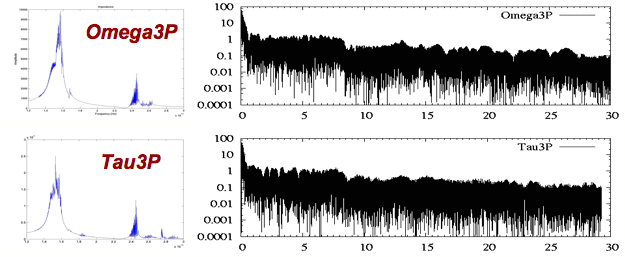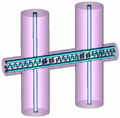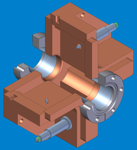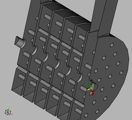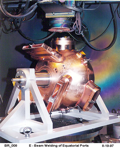| Panel | ||||||||||||
|---|---|---|---|---|---|---|---|---|---|---|---|---|
| ||||||||||||
|
Cell Design for Damped Detuned Structure (DDS) of the Next Linear Collider (NLC)
...
Wakefield Computation for the NLC H60VG3 DDS
The Damped Detuned Structure (DDS) for the Next Linear Collider (NLC) was designed to provide 14% more efficiency. The following is the computer model of the H60VG3 DDS used for wakefield computations.
Using Omega3P by summing over the eigenmodes, the long-range wakefield in the entire 55-cell structure was evaluated. The wakefield agrees well with that obtained by direct simulation of driving a beam in the structure using the time-domain code Tau3P. The following shows the mode spectrum (left) and its summed wakefield (right). It was the first-ever direct wakefield calculation of the DDS and demonstrated the suppression of wakefield at long distances.
Wall loss Q for RIA RFQ
Omega3P was used to model RIA's low energy RFQ. Usind Adaptive Meshing Refinement(AMR) techniques, the accuracies in frequency and wall loss calculations improved by a factor of 10 and 2 respectively, while the CPU time used was a fraction of that without AMR. The improved accuracy of determining the frequency and Q would reduce the number of tuners and tuning range, and thus allowing a better design of the cooling system. Subsequently, this would lead to significant cost saving.
LCLS RF Gun Design
The following is a picture of the LCLS RF gun successfully commissioned in early 2007.
| Wiki Markup |
|---|
{center:class=myclass}
!Omega3pAccompLCLSRFgun.png|width=300!!357px-RFGunQuad.png!
{center} |
Using higher-order basis functions in Omega3P, the dimensions of the gun cavity were accurately determined for fabrication of the above prototype which satisfied the following important design requirements:
- mimized dipole and quadrupole fields via a racetrack dual-feed coupler design,
- reduced pulse heating by rounding of the z-coupling iris.

